| Karkee Web Home Page | Pattern 1958 Home Page | Patt. '58 Components Page |
Web Equipment, Pattern 1958 - Components
Non-Pattern 1958 - Official Issue
Stores Ref. CN 8465-99-973-6103 FROG, No. 6.
Cotton webbing; olive drab; 8 in. lg o/a 1.1/4 in. w
![]()
![]() This was a surprising discovery, as it was listed in the Detail column of a 1976 C.O.S.A. entry. It was dismissed as the usual Army inaccuracy (in describing the W.E. Patt. '37 Frog No. 6), in that it stated “…olive drab…”, a colour also erroneously used to qualify the Patt. ’37 W.E. Haversack in the same publication! It was then forgotten. An example was then found, made by M. Wright & Sons in 1979. The question was then “Who and what for?”
This was a surprising discovery, as it was listed in the Detail column of a 1976 C.O.S.A. entry. It was dismissed as the usual Army inaccuracy (in describing the W.E. Patt. '37 Frog No. 6), in that it stated “…olive drab…”, a colour also erroneously used to qualify the Patt. ’37 W.E. Haversack in the same publication! It was then forgotten. An example was then found, made by M. Wright & Sons in 1979. The question was then “Who and what for?”
The Belt, working existed at this time, complete with matching CN 8465-99-136-6007 Frog, bayonet, Olive drab with Detail of Plastics (polyethylene) webbing. The belt actually did not exist as a discrete item. It was made up from rolls of webbing, cut-off with a hot blade and married to a Patt. ’58 hook-and-loop alloy buckle, with two Keepers in the same polyethylene material. It was an horrendous creation – stiff and not aesthetically pleasing. The Patt. ’37 No. 5 Frog was CN 8465-99-973-6102, the O.D. No. 6 being coded -6103, but the polyethylene Frog code is from a different sequence. It is speculated - only that nylon came first and cotton later, perhaps in recognition of how difficult it was to insert the No. 5 Scabbard into it. From the John Bodsworth Collection. Photos © John Bodsworth 2012.
There were three coded Magazine pouches, the second of which comes in two sizes (possibly even Marks), making four variants in all. All were constructed in the same way, all in green webbing of slightly differing shades and with Patt. ’44 type Quick Release Fasteners (QRF). As any of these can be encountered, all are described below, though only the second to fourth relate to Patt. ’58. Being “un-patterned”, they could have been used with Patt. ’44 as well.
Stores Ref. EXP / CN / 1569 POUCH, AMMUNITION, S.M.C.
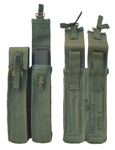 The actual nomenclature is not known, so the second example’s has been “borrowed”. The Sterling was introduced in 1955 and was referred to as a Sub Machine Gun, alongside the Sten Machine Carbine. As contract documentation, concerning this Pouch, specifically mentions the Sten Gun, “S.M.C.” - the Sten Machine Carbine - has been appended.
The actual nomenclature is not known, so the second example’s has been “borrowed”. The Sterling was introduced in 1955 and was referred to as a Sub Machine Gun, alongside the Sten Machine Carbine. As contract documentation, concerning this Pouch, specifically mentions the Sten Gun, “S.M.C.” - the Sten Machine Carbine - has been appended.
All examples so far noted were made in 1955, by a company using only “M” as a marking. They are also all in mint condition, since they were never issued. The code is for Trials purposes, the EXP assumed to translate as Experimental. Two pockets were assembled on a common backing, each with a plain flap fastened with a brass QRF, there being no further attempt at weatherproofing the contents. The flap ends were square, the cut edges protected by a tape edging, with the mouth of each pocket similarly protected. A belt loop was stitched to the back of each pocket.
There was just one problem – every one had been manufactured ½-inch too short, so the Sten magazines would not fit!! From the Carl Woods Collection. Photograph © Carl Woods, 2013.
Stores Ref. CN 1459 POUCH, MAGAZINE, S.M.G., Mk. 1

 The L1A1 Sub Machine Gun (we’d gone American and dropped “Machine Carbine”) had been introduced in 1955 and, unlike the wartime design, its magazines were now curved.
The L1A1 Sub Machine Gun (we’d gone American and dropped “Machine Carbine”) had been introduced in 1955 and, unlike the wartime design, its magazines were now curved.
We are indebted to KWRT Carl Woods who, when asked to supply photographs of EXP / CN / 1569, retrieved all his examples of S.M.G. Pouches. He then noted that an early (date obscured) CN 1459 would not take a Sterling magazine, whereas a 1964 dated example did, albeit as a tight fight. This would seem evidence for early examples being the “Mark 1”, the QR Staple position used on EXP 1569 being altered to a higher position, to give greater accommodation. However, the 1960 edition of C.C.N. also quotes Pouch, magazine, Mk. 2, so the de facto Mark 1 may yet be the failed EXP design above. The case is “Non Proven”, as the Scots might term it! From the Carl Woods Collection. Photographs © Carl Woods, 2013.
Stores Ref. CN 1459 POUCH, MAGAZINE, S.M.G., Mk. 2
Stores Ref. CN 8465-99-973-6261 POUCH, MAGAZINE, S.M.G., Mk. 2
If the above speculation for a Mark 1 Pouch is true, then a reason exists for a Mark 2 version of the same code. The modification for Mark 1 was plainly insufficient and this example by MECo, made in 1964 - which has to be a Mark 2 – has been made physically longer.

 Its QRFs were now black anodised aluminium, again of Patt. ’44 forms, like the later S.A.S. items would use. The earliest example noted is the 1964 example illustrated, which still had a CN code, although the 1960 edition of C.C.N. listed the Pouch Mk. 2, which means it could be used with Patt. ’58 W.E.. The nomenclature should also mean that this was Sterling-specific and rusty witness marks confirm its use in this role. Under the NSN coding system, the code changed as shown above, though no example has yet been seen with this code.
Its QRFs were now black anodised aluminium, again of Patt. ’44 forms, like the later S.A.S. items would use. The earliest example noted is the 1964 example illustrated, which still had a CN code, although the 1960 edition of C.C.N. listed the Pouch Mk. 2, which means it could be used with Patt. ’58 W.E.. The nomenclature should also mean that this was Sterling-specific and rusty witness marks confirm its use in this role. Under the NSN coding system, the code changed as shown above, though no example has yet been seen with this code. 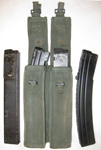
It might be thought that the Sterling magazine was shorter, by virtue of its curvature. As can be seen, this is not the case. At left are Sten magazines, Sterling on the right, in this comparative shot on the right. The off-set rust marks show that this Pouch was used for Sterling magazines. From the Mark Palmer Collection. Photographs © Mark Palmer, 2013.

 Another example, dated 1964. From the Carl Woods Collection. Photographs © Carl Woods, 2013.
Another example, dated 1964. From the Carl Woods Collection. Photographs © Carl Woods, 2013.
Stores Ref. CN 8465-99-136-1905 POUCH, AMMUNITION, STIRLING (sic) MACHINE GUN (sic)


 This still larger Pouch was not listed in the 1965 C.C.N. Section CN, appearing between the 1970 and 1976 C.O.S.A. editions. The spelling should be noted, as it is an exact rendition from COSAs. The Army cannot even spell their weapon names correctly, quite apart from placing it in an over-ambitious weapon grouping! It should be the Sterling, a very late war design from Mr. Patchett, which was manufactured by Sterling Engineering. The same linked double pocket Carrier was now manufactured in a still larger size, but was otherwise identical to CN 1459, with the same Patt. ’44 QRFs. This example was made by M.W.& S. in 1974. Though straight, the pockets also had increased width to allow for their curved contents. The “set” - due to prolonged use - is therefore less marked. The photo at right shows Sten magazines in a 2nd Issue CN 1459, with a -1509 on the right. Pouches from the Mark Palmer Collection. Photographs © Mark Palmer, 2013.
This still larger Pouch was not listed in the 1965 C.C.N. Section CN, appearing between the 1970 and 1976 C.O.S.A. editions. The spelling should be noted, as it is an exact rendition from COSAs. The Army cannot even spell their weapon names correctly, quite apart from placing it in an over-ambitious weapon grouping! It should be the Sterling, a very late war design from Mr. Patchett, which was manufactured by Sterling Engineering. The same linked double pocket Carrier was now manufactured in a still larger size, but was otherwise identical to CN 1459, with the same Patt. ’44 QRFs. This example was made by M.W.& S. in 1974. Though straight, the pockets also had increased width to allow for their curved contents. The “set” - due to prolonged use - is therefore less marked. The photo at right shows Sten magazines in a 2nd Issue CN 1459, with a -1509 on the right. Pouches from the Mark Palmer Collection. Photographs © Mark Palmer, 2013.

 Another example, again by M.W. & S. and made in 1977, from the Carl Woods Collection. Photographs © Carl Woods 2013.
Another example, again by M.W. & S. and made in 1977, from the Carl Woods Collection. Photographs © Carl Woods 2013.
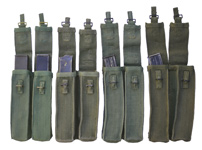 The four distinct issues are illustrated at left, EXP 1569 on the left extending to 8465-99-136-1905 on the right. The early CN 1459, 2nd from left, has its QR Staple raised slightly, but still with the same size of flap. Third from left, a late issue CN 1459 has the pocket bodies lengthened, the QR Staple is moved up again and the flaps are longer. The final issue on the right has pockets and flaps lengthened still further and the QR Staple is raised yet again. Its body is also slightly wider, so the curved Sterling magazine distorts it less than the CN 1459 third from left.
The four distinct issues are illustrated at left, EXP 1569 on the left extending to 8465-99-136-1905 on the right. The early CN 1459, 2nd from left, has its QR Staple raised slightly, but still with the same size of flap. Third from left, a late issue CN 1459 has the pocket bodies lengthened, the QR Staple is moved up again and the flaps are longer. The final issue on the right has pockets and flaps lengthened still further and the QR Staple is raised yet again. Its body is also slightly wider, so the curved Sterling magazine distorts it less than the CN 1459 third from left.
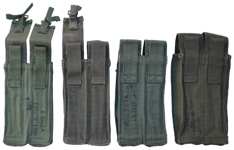 The same Pouch group shows variation in the position of the belt loops and their lengths. At extreme left, EXP 1569 has narrow loops, second left has wider loops, set slightly higher, but of the same belt accommodation. Third left has the loops moved up still further, whilst at extreme right, -136-1509 has loops of greater strap accommodation and which are positioned higher again.
The same Pouch group shows variation in the position of the belt loops and their lengths. At extreme left, EXP 1569 has narrow loops, second left has wider loops, set slightly higher, but of the same belt accommodation. Third left has the loops moved up still further, whilst at extreme right, -136-1509 has loops of greater strap accommodation and which are positioned higher again.
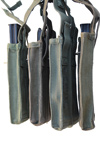 This side view of the group, EXP 1569 at left, -1509 at right, shows the construction to good advantage. It all seems reminiscent of Goldilocks, but going one better! EXPN 1569 had been too small, early CN 1459 was still not big enough, but later CN 1459 was still not equal to the task, so -136-1509 - the fourth attempt - was just right at last! Note also the orientation of the magazines, some being shown mouth uppermost. With no side protection from the weather, it made more sense to carry magazines with their baseplates uppermost – which also made them easier to insert / extract. Pouch groups from the Carl Woods Collection. Photographs © Carl Woods, 2012.
This side view of the group, EXP 1569 at left, -1509 at right, shows the construction to good advantage. It all seems reminiscent of Goldilocks, but going one better! EXPN 1569 had been too small, early CN 1459 was still not big enough, but later CN 1459 was still not equal to the task, so -136-1509 - the fourth attempt - was just right at last! Note also the orientation of the magazines, some being shown mouth uppermost. With no side protection from the weather, it made more sense to carry magazines with their baseplates uppermost – which also made them easier to insert / extract. Pouch groups from the Carl Woods Collection. Photographs © Carl Woods, 2012.
First introduced as the Patchett Machine Carbine in 1944, it played second fiddle to the Sten Machine Carbine Mark 5, until the revised Sterling appeared in 1955. Much later, the SA 80, or L85A1, obviated the need for an SMG and the Sterling was made obsolete in 1994.
Stores Ref. CN 6520-99-102-XXXX (6?19?2?) POUCH, FIRST AID (Exact nomenclature not yet determined)


 A soldier’s First Aid, right back to the Boer War, comprised just a First Field Dressing. With the introduction of drab Service Dress in 1902, a pocket was sewn inside the right skirt corner of the S.D. Jacket. When Battle Dress was introduced in 1938, an external pocket on the right B.D. Trousers’ leg contained the same dressing, often of Great War dates too! American soldiers carried a webbing pocket on their accoutrements, which contained a Carlisle Dressing, akin to a First Field Dressing. It fell to the U.S. Marine Corps to provide a larger First aid pouch, containing far more items. In the British Army, the U.S.M.C. approach took rather longer. From the Rog Dennis Collection. Photos © Rog Dennis 2012.
A soldier’s First Aid, right back to the Boer War, comprised just a First Field Dressing. With the introduction of drab Service Dress in 1902, a pocket was sewn inside the right skirt corner of the S.D. Jacket. When Battle Dress was introduced in 1938, an external pocket on the right B.D. Trousers’ leg contained the same dressing, often of Great War dates too! American soldiers carried a webbing pocket on their accoutrements, which contained a Carlisle Dressing, akin to a First Field Dressing. It fell to the U.S. Marine Corps to provide a larger First aid pouch, containing far more items. In the British Army, the U.S.M.C. approach took rather longer. From the Rog Dennis Collection. Photos © Rog Dennis 2012.
A pocket approximately 6 x 4 x 2-inches, was fitted on its long axis with two narrow webbing loops. These allowed it to be threaded onto the front Yoke straps. Closure was by box-lid flap, with a turn button.
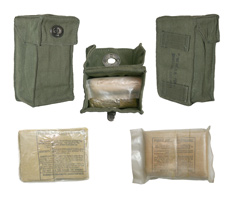
 The identification as a First aid pouch is hearsay, but KWRT John Bodsworth has established that two First Field Dressing packages do fit neatly into the pouch, each package containing two dressings. The dressing re-sealed in a polythene bag is dated 1942. Waste not, want not!!
The identification as a First aid pouch is hearsay, but KWRT John Bodsworth has established that two First Field Dressing packages do fit neatly into the pouch, each package containing two dressings. The dressing re-sealed in a polythene bag is dated 1942. Waste not, want not!!
John has speculated that it was a necessary item when NBC clothing was worn. The Pattern 1960 Combat Trousers had an FFD pocket high on the right front leg, as once Battle Dress Trousers had had. NBC clothing was not so equipped and accessing the Combat Trousers’ pocket would have been impossible. By carrying FFDs on the Yoke braces, they were once more accessible.
If this explanation holds water, it was from the mid 60s into the 70s, but the size of the FFD was then increased. Also, the thin cotton covering – a method dating back to the Great War – was changed to a rubberised fabric, making the packaging far more robust. As a consequence, the new dressings did not fit the Pouch, which is probably why photographs instead show the dressing black-taped to the Yoke flare. From the John Bodsworth Collection. Photograph © John Bodsworth, 2013.
The photo at right above, from the Rog Dennis Collection, is the only one we've seen that shows this Pouch in use. It's a bit of a puzzle, though, as Rog has only a hard copy on file, and unfortunately no idea where it came from! We can tell it dates from the 70s, as he's in a DPM Combat Smock, but is wearing Lightweight OG trousers. Can any reader provide more information?
The continuing problem is lack of official documentation for medical stores. Can any reader help?
Stores Ref. CN 8465-99-135-7280 SOCKET, RIFLE SUPPORTING


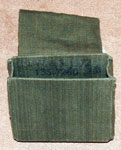 This item appeared very late, being required in Northern Ireland. It was also marked in COSA as an “…MOD controlled…” item. An open-topped pocket, fibre stiffened on front and rear faces, was supported on a dropped belt loop, although a pair of “C” hooks was also located on the back of the Socket. This was worn on the front of the Belt, providing support for the S.L.R. butt, when on patrol, where the rifle was carried very much at the Ready. From the John Bodsworth Collection. Photos © John Bodsworth 2012.
This item appeared very late, being required in Northern Ireland. It was also marked in COSA as an “…MOD controlled…” item. An open-topped pocket, fibre stiffened on front and rear faces, was supported on a dropped belt loop, although a pair of “C” hooks was also located on the back of the Socket. This was worn on the front of the Belt, providing support for the S.L.R. butt, when on patrol, where the rifle was carried very much at the Ready. From the John Bodsworth Collection. Photos © John Bodsworth 2012.
Stores Ref. XX XXXX-99-XXX-XXXX RUNNER, BELT, WITH SNAP HOOK
![]()
![]()
![]() The COSA Section, NSN Group / Class code and NIIN code are all unknown, as its official nomenclature and purpose. Because it uses a levered snap hook, it is included under Patt. ’58 – until we, or you can tell us more! It may be an updated version of the Runner, swivel of a Linesman’s belt, to which the issue clasp knife could be attached.
The COSA Section, NSN Group / Class code and NIIN code are all unknown, as its official nomenclature and purpose. Because it uses a levered snap hook, it is included under Patt. ’58 – until we, or you can tell us more! It may be an updated version of the Runner, swivel of a Linesman’s belt, to which the issue clasp knife could be attached.
8415-99-132-4007 was a Bag, carrying for the Combat Helmet, N.I. Pattern, but this Runner has been suggested as a means of hanging the Combat-, or Anti-Riot Helmet when not in use, rather than struggle to get it out of a Bag…? This example, made by M.E.Co. in 1978, is from the Jim Harriss Collection. Photographs © Jim Harris, 2013.
Rog Dennis, revised 2013